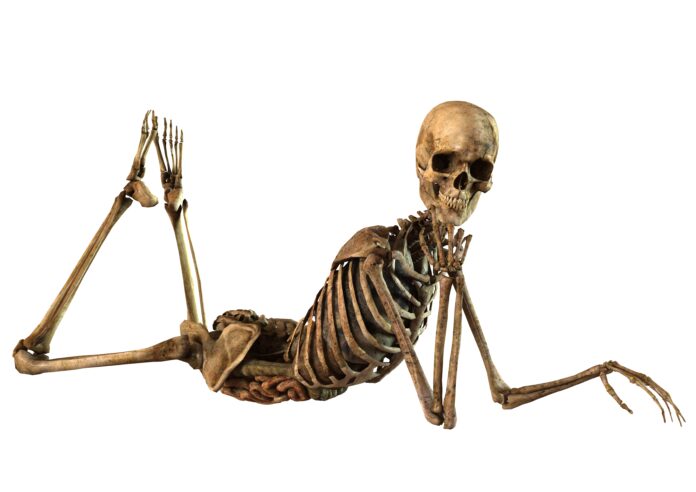It’s frightfully common for anti-transgender activists to rely on comfortable tropes in places of actual arguments, and one of the favorites in the arsenal nowadays seems simple on the surface, but gets crueler the deeper you dig.
The question is posed something like this: Sure, they’ll say, you might be seen as a woman, but what happens, in a thousand years when future archeologists exhume your remains? Then they’ll call you a man based on your skeleton. There’s nothing you can do to change that biological fact, they’ll conclude. Gotcha!
This sure sounds like an open and shut case, does it not? We all have a basic understanding that the experts can look at a skeleton and tell if the person was male or female, likely based on the shape of one’s pubic bones, or maybe even just the overall size of the remains.
Of course, they’ll also conclude, those future scientists will simply collect a long-dormant DNA sample, and spot those pesky “X” and “Y” chromosomes, and then know the undisputed scientific truth.
It all certainly sounds plausible, no doubt, and fits with one’s basic understanding of how sex differences work. At the same time, it is a very basic, surface response to a very complex question.
We already know that chromosomes are not the perfect indicator we would hope them to be. Yes, it’s pretty common, but it is not a perfect indicator.
As much as we’d like a simple answer, we know that chromosomes themselves do not define gender. Aside from the fact that a person could have XX chromosomes and be a man — gender is different from sex, after all — this doesn’t account for scores of possibilities beyond the basics.
What about the bones, you say? Even if the chromosomes aren’t the perfect indicator, surely the bones will tell the truth?
Once again, we find ourselves facing the same conundrum. Yes, it can give you some ideas, but it’s not perfect. Not all bone structures are identical, and while we can point to probability — i.e., most male skeletons may be larger and more robust, or have less angular pelvises, it’s not an absolute, and is far less likely to be conclusive in younger skeletal remains.
What’s more, archeologists are not spending their time applying calipers to skulls when they look at such remains: they are looking at the burial as a whole. If they are finding, for example, burial items more typically associated with a male member of a group — even if skeletal evidence may indicate a female — they will conclude that the individual in question was treated as a man, if not as third gendered or in some other category.
It’s much like how I might be treated if I were buried today. An exhumation of my body would reveal elements more in common with other women, rather than men, and any records of my life would make it clear that I was considered a woman in my day-to-day life.
I invite you to take this question to a next level, however. When this question of what some mythological future archeologist will see when they view our bones, it’s not so much about a search for scientific truth, even if it feels like such.
No, it is about mocking transgender people.
It is a way of saying that a trans woman, no matter what they do, can never be a “real” woman, nor can a trans man be a “real” man. Further, a nonbinary person cannot exist, as “scientific truth” will always choose a binary option. This isn’t about the future, but the ghosts of our pasts.
It ignores the fact that we’re not living in that far-flung future, but are living right now. My name is a feminine one, and my legal paperwork displays an “F” on it. I am seen publicly as just another woman in this world, albeit one who makes it clear that she is transgender. My friends, my family, my workplace, and frankly, everyone from the guy I have nice chats with down the street to the woman who usually checks through my weekly groceries knows my gender.
Even more to the point, I know my gender. I’ve known it since I had the words to understand, and have gone through great pains to understand myself, and present the person I am to the world. Never mind that I don’t think my remains would ever merit study by future archeologists, and even if they did opt to examine them, I intend to be cremated, leaving a handful or two of gray ash studded with the occasional fleck of bone.
Yet there’s still another layer.
In asking this, the questioner is also creating a future world where transgender people do not exist, and where their worldview is what matters. A world where there is but “man” and “woman,” and those are rigidly enforced. After all, why would it matter in the far future what the supposed sex of a pile of bones were?
What, then, do they expect caused my bones to be so disposed of, and what is this weird world they are envisioning? What specter are they raising in asking this simple question?
Ultimately, we don’t need some provocative thought experiment. We are living now, and I am in the world right now. I need my rights now, not in 1000 years when I am but a pile of ashes. Who I am now matters, not what someone might think centuries into the future.
Gwen Smith is more than the sum of her parts. You’ll find her at www.gwensmith.com.
